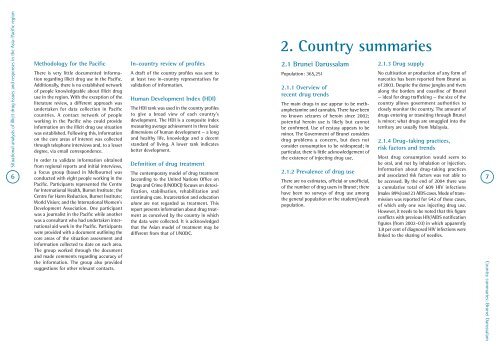Illicit Drug use in the Asia Pacific Region - Burnet Institute
Illicit Drug use in the Asia Pacific Region - Burnet Institute
Illicit Drug use in the Asia Pacific Region - Burnet Institute
You also want an ePaper? Increase the reach of your titles
YUMPU automatically turns print PDFs into web optimized ePapers that Google loves.
Situational analysis of illicit drug issues and responses <strong>in</strong> <strong>the</strong> <strong>Asia</strong>–<strong>Pacific</strong> region<br />
6<br />
Methodology for <strong>the</strong> <strong>Pacific</strong><br />
There is very little documented <strong>in</strong>formation<br />
regard<strong>in</strong>g illicit drug <strong>use</strong> <strong>in</strong> <strong>the</strong> <strong>Pacific</strong> .<br />
Additionally, <strong>the</strong>re is no established network<br />
of people knowledgeable about illicit drug<br />
<strong>use</strong> <strong>in</strong> <strong>the</strong> region . With <strong>the</strong> exception of <strong>the</strong><br />
literature review, a different approach was<br />
undertaken for data collection <strong>in</strong> <strong>Pacific</strong><br />
countries . A contact network of people<br />
work<strong>in</strong>g <strong>in</strong> <strong>the</strong> <strong>Pacific</strong> who could provide<br />
<strong>in</strong>formation on <strong>the</strong> illicit drug <strong>use</strong> situation<br />
was established . Follow<strong>in</strong>g this, <strong>in</strong>formation<br />
on <strong>the</strong> core areas of <strong>in</strong>terest was collected<br />
through telephone <strong>in</strong>terviews and, to a lesser<br />
degree, via email correspondence .<br />
In order to validate <strong>in</strong>formation obta<strong>in</strong>ed<br />
from regional reports and <strong>in</strong>itial <strong>in</strong>terviews,<br />
a focus group (based <strong>in</strong> Melbourne) was<br />
conducted with eight people work<strong>in</strong>g <strong>in</strong> <strong>the</strong><br />
<strong>Pacific</strong> . Participants represented <strong>the</strong> Centre<br />
for International Health, <strong>Burnet</strong> <strong>Institute</strong>; <strong>the</strong><br />
Centre for Harm Reduction, <strong>Burnet</strong> <strong>Institute</strong>;<br />
World Vision; and <strong>the</strong> International Women’s<br />
Development Association . One participant<br />
was a journalist <strong>in</strong> <strong>the</strong> <strong>Pacific</strong> while ano<strong>the</strong>r<br />
was a consultant who had undertaken <strong>in</strong>ternational<br />
aid work <strong>in</strong> <strong>the</strong> <strong>Pacific</strong> . Participants<br />
were provided with a document outl<strong>in</strong><strong>in</strong>g <strong>the</strong><br />
core areas of <strong>the</strong> situation assessment and<br />
<strong>in</strong>formation collected to date on each area .<br />
The group worked through <strong>the</strong> document<br />
and made comments regard<strong>in</strong>g accuracy of<br />
<strong>the</strong> <strong>in</strong>formation . The group also provided<br />
suggestions for o<strong>the</strong>r relevant contacts .<br />
In-country review of profiles<br />
A draft of <strong>the</strong> country profiles was sent to<br />
at least two <strong>in</strong>-country representatives for<br />
validation of <strong>in</strong>formation .<br />
Human Development Index (HDI)<br />
The HDI rank was <strong>use</strong>d <strong>in</strong> <strong>the</strong> country profiles<br />
to give a broad view of each country’s<br />
development . The HDI is a composite <strong>in</strong>dex<br />
measur<strong>in</strong>g average achievement <strong>in</strong> three basic<br />
dimensions of human development — a long<br />
and healthy life, knowledge and a decent<br />
standard of liv<strong>in</strong>g . A lower rank <strong>in</strong>dicates<br />
better development .<br />
Def<strong>in</strong>ition of drug treatment<br />
The contemporary model of drug treatment<br />
(accord<strong>in</strong>g to <strong>the</strong> United Nations Office on<br />
<strong>Drug</strong>s and Crime (UNODC)) foc<strong>use</strong>s on detoxification,<br />
stabilisation, rehabilitation and<br />
cont<strong>in</strong>u<strong>in</strong>g care . Incarceration and education<br />
alone are not regarded as treatment . This<br />
report presents <strong>in</strong>formation about drug treatment<br />
as conceived by <strong>the</strong> country <strong>in</strong> which<br />
<strong>the</strong> data were collected . It is acknowledged<br />
that <strong>the</strong> <strong>Asia</strong>n model of treatment may be<br />
different from that of UNODC .<br />
2 . Country summaries<br />
2 .1 Brunei Darussalam<br />
Population: 365,251<br />
2 .1 .1 Overview of<br />
recent drug trends<br />
The ma<strong>in</strong> drugs <strong>in</strong> <strong>use</strong> appear to be methamphetam<strong>in</strong>e<br />
and cannabis . There have been<br />
no known seizures of hero<strong>in</strong> s<strong>in</strong>ce 2002;<br />
potential hero<strong>in</strong> <strong>use</strong> is likely but cannot<br />
be confirmed . Use of ecstasy appears to be<br />
m<strong>in</strong>or . The Government of Brunei considers<br />
drug problems a concern, but does not<br />
consider consumption to be widespread; <strong>in</strong><br />
particular, <strong>the</strong>re is little acknowledgement of<br />
<strong>the</strong> existence of <strong>in</strong>ject<strong>in</strong>g drug <strong>use</strong> .<br />
2 .1 .2 Prevalence of drug <strong>use</strong><br />
There are no estimates, official or unofficial,<br />
of <strong>the</strong> number of drug <strong>use</strong>rs <strong>in</strong> Brunei; <strong>the</strong>re<br />
have been no surveys of drug <strong>use</strong> among<br />
<strong>the</strong> general population or <strong>the</strong> student/youth<br />
population .<br />
2 .1 .3 <strong>Drug</strong> supply<br />
No cultivation or production of any form of<br />
narcotics has been reported from Brunei as<br />
of 2003 . Despite <strong>the</strong> dense jungles and rivers<br />
along <strong>the</strong> borders and coastl<strong>in</strong>e of Brunei<br />
— ideal for drug traffick<strong>in</strong>g — <strong>the</strong> size of <strong>the</strong><br />
country allows government authorities to<br />
closely monitor <strong>the</strong> country . The amount of<br />
drugs enter<strong>in</strong>g or transit<strong>in</strong>g through Brunei<br />
is m<strong>in</strong>or; what drugs are smuggled <strong>in</strong>to <strong>the</strong><br />
territory are usually from Malaysia .<br />
2 .1 .4 <strong>Drug</strong>-tak<strong>in</strong>g practices,<br />
risk factors and trends<br />
Most drug consumption would seem to<br />
be oral, and not by <strong>in</strong>halation or <strong>in</strong>jection .<br />
Information about drug-tak<strong>in</strong>g practices<br />
and associated risk factors was not able to<br />
be accessed . By <strong>the</strong> end of 2004 <strong>the</strong>re was<br />
a cumulative total of 609 HIV <strong>in</strong>fections<br />
(males 89%) and 23 AIDS cases . Mode of transmission<br />
was reported for 542 of <strong>the</strong>se cases,<br />
of which only one was <strong>in</strong>ject<strong>in</strong>g drug <strong>use</strong> .<br />
However, it needs to be noted that this figure<br />
conflicts with previous HIV/AIDS notification<br />
figures (from 2002–03) <strong>in</strong> which apparently<br />
3 .8 per cent of diagnosed HIV <strong>in</strong>fections were<br />
l<strong>in</strong>ked to <strong>the</strong> shar<strong>in</strong>g of needles .<br />
7<br />
Country summaries: Brunei Darussalam









